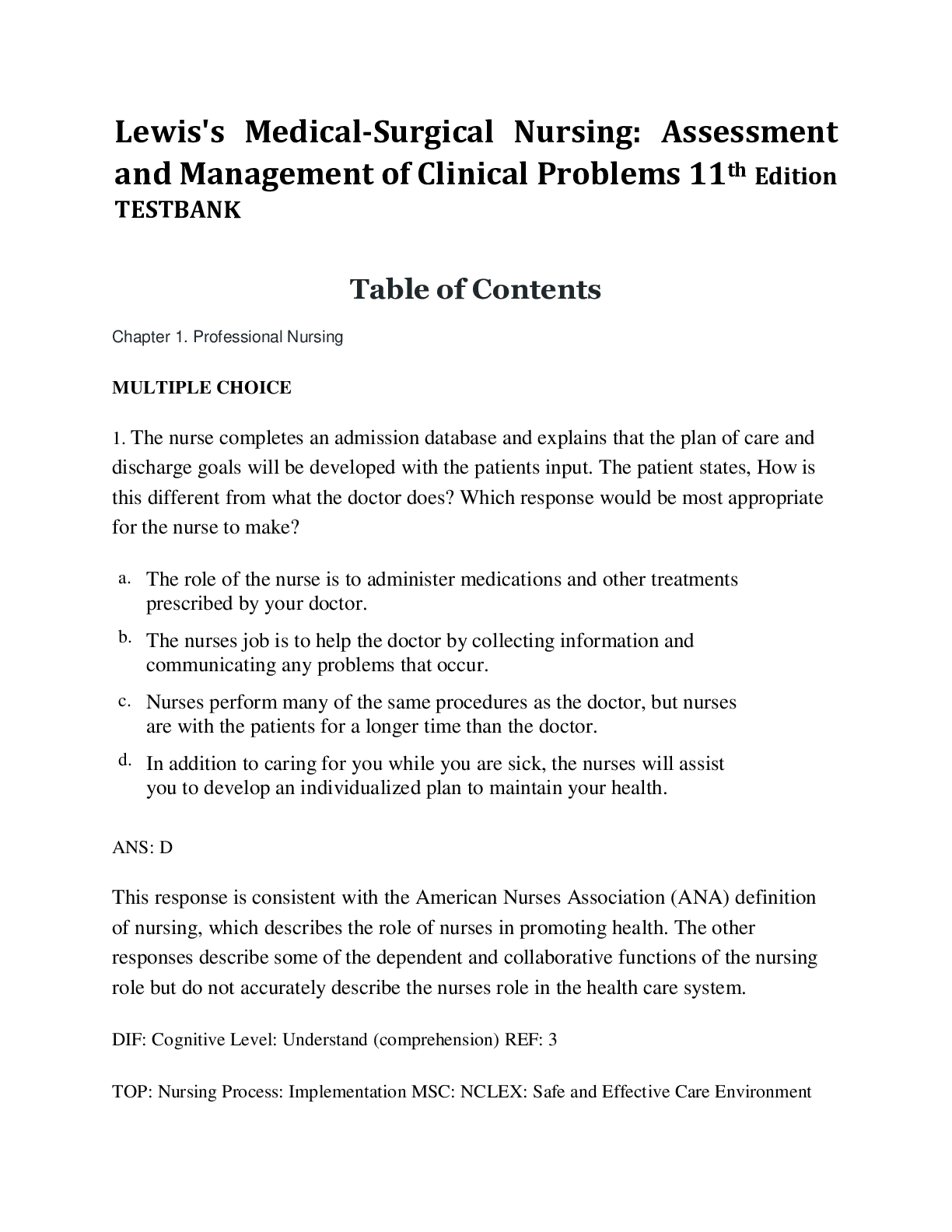Nursing > Questions and Answers > Lewis's Medical-Surgical Nursing: Assessment and Management of Clinical Problems TESTBANK
Lewis's Medical-Surgical Nursing: Assessment and Management of Clinical Problems TESTBANK
1. The nurse completes an admission database and explains that the plan of care and discharge goals will be developed with the patients input. The patient states, How is this different from what the doctor does? Which response would be most appropriate for the nurse to make? a. The role of the nurs ... e is to administer medications and other treatments prescribed by your doctor. b. The nurses job is to help the doctor by collecting information and communicating any problems that occur. c. Nurses perform many of the same procedures as the doctor, but nurses are with the patients for a longer time than the doctor. d. In addition to caring for you while you are sick, the nurses will assist you to develop an individualized plan to maintain your health. 2. The nurse describes to a student nurse how to use evidence-based practice guidelines when caring for patients. Which statement, if made by the nurse, would be the most accurate? a. Inferences from clinical research studies are used as a guide. b. Patient care is based on clinical judgment, experience, and traditions. c. Data are evaluated to show that the patient outcomes are consistently met. d. Recommendations are based on research, clinical expertise, and patient preferences. 3. The nurse teaches a student nurse about how to apply the nursing process when providing patient care. Which statement, if made by the student nurse, indicates that teaching was successful? a. The nursing process is a scientific-based method of diagnosing the patients health care problems. b. The nursing process is a problem-solving tool used to identify and treat patients health care needs. c. The nursing process is based on nursing theory that incorporates the biopsychosocial nature of humans. d. The nursing process is used primarily to explain nursing interventions to other health care professionals. 4. A patient has been admitted to the hospital for surgery and tells the nurse, I do not feel comfortable leaving my children with my parents. Which action should the nurse take next? a. Reassure the patient that these feelings are common for parents. b. Have the patient call the children to ensure that they are doing well. c. Gather more data about the patients feelings about the child-care arrangements. d. Call the patients parents to determine whether adequate child care is being provided. 5. A patient who is paralyzed on the left side of the body after a stroke develops a pressure ulcer on the left hip. Which nursing diagnosis is most appropriate? a. Impaired physical mobility related to left-sided paralysis b. Risk for impaired tissue integrity related to left-sided weakness c. Impaired skin integrity related to altered circulation and pressure d. Ineffective tissue perfusion related to inability to move independently 6. A patient with a bacterial infection has a nursing diagnosis of deficient fluid volume related to excessive diaphoresis. Which outcome would the nurse recognize as most appropriate for this patient? a. Patient has a balanced intake and output. b. Patients bedding is changed when it becomes damp. c. Patient understands the need for increased fluid intake. d. Patients skin remains cool and dry throughout hospitalization. 7. A nurse asks the patient if pain was relieved after receiving medication. What is the purpose of the evaluation phase of the nursing process? a. To determine if interventions have been effective in meeting patient outcomes b. To document the nursing care plan in the progress notes of the medical record c. To decide whether the patients health problems have been completely resolved d. To establish if the patient agrees that the nursing care provided was satisfactory 8. The nurse interviews a patient while completing the health history and physical examination. What is the purpose of the assessment phase of the nursing process? a. To teach interventions that relieve health problems b. To use patient data to evaluate patient care outcomes c. To obtain data with which to diagnose patient problems d. To help the patient identify realistic outcomes for health problems 9. Which nursing diagnosis statement is written correctly? a. Altered tissue perfusion related to heart failure b. Risk for impaired tissue integrity related to sacral redness c. Ineffective coping related to response to biopsy test results d. Altered urinary elimination related to urinary tract infection 10. The nurse admits a patient to the hospital and develops a plan of care. What components should the nurse include in the nursing diagnosis statement? a. The problem and the suggested patient goals or outcomes b. The problem with possible causes and the planned interventions c. The problem, its cause, and objective data that support the problem d. The problem with an etiology and the signs and symptoms of the problem [Show More]

Written for
Category:
Questions and Answers
Course:
Nursing
Last updated at :
1 year ago